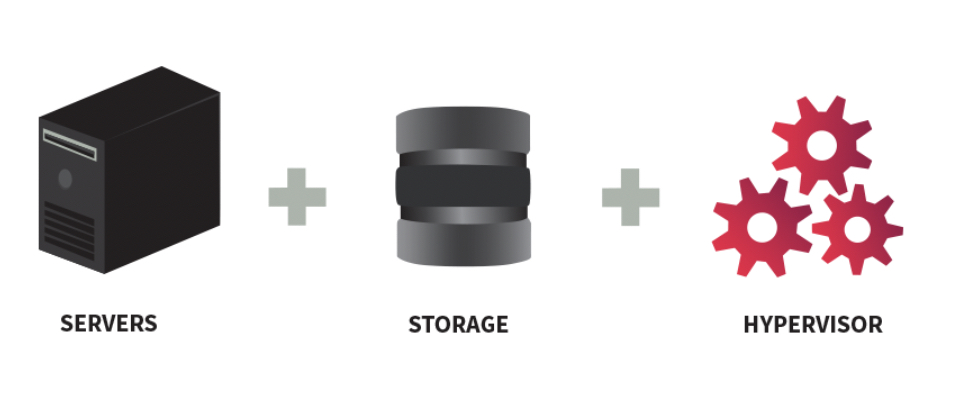
By Darren Giacomini
Advances In Infrastructure That Reduce Complexity
As BCDVideo closes out another expo attending ISC West 2019, one theme resonated throughout the show. System Integrators are looking for ways to deliver better solutions, leverage emerging technologies, and advance the capabilities of physical security infrastructures. One of the focal points for BCDVideo this year is hyperconvergence systems, or Hyperconverged Infrastructure (HCI).
What Is Hyperconvergence?
Hyperconverged Infrastructure consolidates software-defined compute, storage, and networking into one cluster to provide high-performance, cost-effective, and easily scalable virtualization.
( See Darren’s previous article on this at https://security.world/virtualization-and-hyperconvergence-a-primer/. )
The concept of virtualization has been hovering around expos like ISC for many years, yet few integrators or video surveillance manufacturers have adopted it or embraced the concepts. It is a well-known fact that virtualization leads to more efficient use of hardware, lower physical footprint, and reduces power and cooling costs.
With such an upside, why has our industry been so slow to embrace or implement it? The answer is simple — complexity. With many integrators shifting between small jobs and larger projects, sending technicians out for months of training to support “virtualization” does not resonate well with integrators and is hard to justify a return on such investment.
The Argument for Hyperconvergence for Physical Security:
The key to hyperconvergence and virtualization for the physical security market hinges on the effective utilization of resources. Regardless of the platform you run on, server resources are rarely used efficiently or to their full potential.
Watch this video to get a quick understanding on the ease of setting up a HCI infrastructure.
Using a typical video archiver as an example, CPU and memory resources rarely peak above sixty percent utilization and actually average about forty percent utilization. The inefficient use of the physical resources is software bound, meaning the software is going to reach its full potential long before the hardware does.
What happens to the remaining resources that are unused? In a “bare metal” world — nothing! Resources sit dormant, never reaching their full potential. When you virtualize and hyperconverge, you create a pool of resources for the cluster. Resources that are utilized by the virtual server are released back to the pool and made available to other services.
Leveraging virtualization and Hyperconvergence allows integrators to not only better utilize bare-metal resources but also combine server resources for surveillance, access control, and building management while reducing the overall footprint of the solution.
In addition to reducing the physical footprint, integrators can significantly reduce the total cost of ownership associated with power and cooling while providing fault tolerance that may not be available otherwise.
Providing New Levels of Fault Tolerance Leveraging Hyperconvergence:
The concepts of virtualization and hyperconvergence are based on the principals of resource sharing or pooling of resources. When both resources and data-stores are shared in a resilient fashion, the virtual machines can exhibit fault tolerance that is no longer bound by the physical server they reside on.
Each virtual machine has the ability to run on any of the physical servers within the shared resource pool and can be migrated between servers with minimal impact to the production environment.
A live migration is a scenario where the active running virtual machine is moved between servers without failure of hardware. This live migration is often done to balance resources, or temporarily remove a server from the pool for maintenance or technical malfunction.
While live migration does provide flexibility, the real value in hyperconvergence is in the resiliency provided during “node” or server failure. If a server within a Hyperconverged cluster fails at any time, all virtual machines that reside on that server will automatically migrate to other physical servers within the cluster and reboot.
Within eight to 10 minutes not only will all of the virtual machines be back online they will have full access to all data that was available prior to the failure. Recovery of the virtual machines, and restoration of the data is an automated process that recovers in an unattended fashion.
At the end of the day, this means that virtual machines will gracefully recover with no interaction from the end user – or the integrator. In comparison, servers running on physical hardware, only recover their data once the server has been inspected, repaired, and put back online.
With the virtualization automated recovery process, and virtual machine migration, highlights another key point associated with hyperconvergence. Hyperconvergence allows fault tolerance for servers that do not currently offer high availability failover.
There is a high number of video management systems (VMS) and access control vendors that simply do not offer failover capabilities. By deploying these products on a hyperconverged infrastructure, you immediately provide fault tolerance for the server and all underlying software running on that server.
In essence, hyperconvergence allows you to apply high availability to platforms that do not currently offer it today. All of these attributes make a compelling argument for both hyperconvergence and virtualization, but even the best technologies built on complexity are destined to fail. It is imperative that simplicity be engineered at the very core of any hyperconvergence solution for it to success in the physical security market.
Hyperconvergence and Virtualization without the Complexity:
Until this year, my views of virtualization and hyperconvergence fell in line with the traditional I.T. approach. VMWare, Hyper-V, and KVM dominated the industry, but all had levels of complexity that were better suited to the I.T. market then our physical security-oriented environments.
Sure, there were plenty of surveillance and physical security applications that were leveraging this technology, but they were always backed by an army of IT professionals to support it. Around July of last year, BCDVideo began a joint venture with Scale Computing to deliver a simplified hyperconverged solution that was not only attainable by all but engineered to support the needs of the physical security market.
Scale Computing takes a very unique approach to both virtualization and hyperconvergence.
Simplicity and automation are the very pillars that the Scale Computing solution is built on. Leveraging the KVM hypervisor, Scale Computing has taken the complicated world for virtualization and Hyperconvergence and made it simple.
Incredibly simple that integrators can often deploy their first virtualized and hyperconverged solutions within minutes of being introduced to the product.
At ISC West 2019, BCDVideo announced their hyperconverged solution (HCI-VS) based on Scale Computing which is Genetec self-certified at 2200 Mbps and 12 VMs. Throughout the show, I watched people who had never worked with either hyperconvergence or virtualization, deploy their first high-availability, virtualized environments within minutes.
The strength of BCDVideo’s HCI-VS solution is that it does not require months —or years— of training. In fact, I’m confident I can take any technician and within an hour they could be deploying hyperconverged solutions with little training.
Hyperconvergence and virtualization will have a big impact on the physical security market in the coming years. Simply put, there is too much upside for the technology to be ignored within our market.
The benefit of BCDVideo’s HCI-VS to the user starts with lower cost of ownership and ends with a simplistic approach to state-of-the-art technology, built exclusively for the security industry. BCDVideo, the leader in purpose-build access control, surveillance recording, and networking infrastructure, delivers accountability, scalability, reliability, and affordability to the hyperconverged marketplace.
Why This Matters and Why This Is A Game Changer
The security industry has its share of traditional hyperconverged solution providers. All are very formidable system but come at an expense beyond the initial cost of the hardware; personal trained on vSAN, VDI, and/or VxRail expertise, for instance. Whether an on-staff employee or an outsourced contractor, its been a deterrent to security integrators embracing a hyperconverged platform. Merely for the lack of control of the solution.
This was the BCDVideo mindset when they first approached Scale Computing. How can they bring their “easy button” to Hyperconvergence? How can they deliver scale compute and bandwidth in a single cluster in a way that no one has done before? BCDVideo has accomplished both. The security industry now has a much more resilient, reliable, and revolutionary HCI solution at a significantly lower cost that delivers the peace of mind that the security integrator can pass on to their customer.
While all integrators in the physical security market will need to embrace the technology, it does not need to be a technology shrouded in confusion, complexity, and endless training. Sometimes the simplest things can have the biggest impact on our market, HCI-VS by BCDVideo and Scale Computing is no exception. Unleash your path to success by leveraging next-generation technology based on simplicity as opposed to complexity. By empowering the integrator to better service their customer, everyone wins.
About The Author
With more than 16-years of experience in the field, Darren Giacomini manages BCDVideo’s advanced technology portfolio, which includes hyperconverged infrastructure. Giacomini specializes in designing and implementing high availability infrastructures to support real-time video surveillance applications for BCDVideo’s integrator customers. He is a monthly contributor to SecurityWorld, sharing insights and knowledge on physical security networks and what it takes to deliver the most capable video surveillance network infrastructure.


